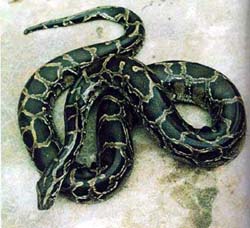Indian Python
(Python molurus birittatus kuhl)
Habitat: reside in forests of the tropical and sub-tropical areas, or evergreen broad-leaved forests and bushes near streams or brooks. So long as the climate of a place is warm and humid and the animal resources of a place is abundant, it will be a good living condition for Indian pythons to live at.
 Feeding habits: it feeds on all kinds of small-sized animals such as rabbits, pheasants, squirrels, birds and birds' eggs, lizards, domestic animals or family fowls. It can eat a lot and can eat as much food as twice of its own weight. But, so long as it is full, it can eat nothing for days. Feeding habits: it feeds on all kinds of small-sized animals such as rabbits, pheasants, squirrels, birds and birds' eggs, lizards, domestic animals or family fowls. It can eat a lot and can eat as much food as twice of its own weight. But, so long as it is full, it can eat nothing for days.
Features: the largest snake in our country with a full body length of over 6-7 m. It's a kind of non-poisonous and primitive snake. There is separately a lip dimple in both its upper and lower lip, which are sensitive infrared sensors. It's of oviparity and it produces its eggs from April to June each year. It can produce more than 100 eggs each time. Female Indian python has the habit to coil on the eggs to hatch its young. During this period, it won't eat or drink; its body can produce heat, which is several centigrade higher than its normal body temperature. This is beneficial for its hatching. It has a life span of more than 25 years.
Category: Reptilia, Squamata, Serpentes, Boidae
Distribution: tropical areas in West and South Yunnan, Guangdong, Guangxi, Fujian, Guizhou and Hainan etc.
Protection level: because of over killing in the original habitats, the number of Indian pythons in wild state is reducing sharply. It is listed as Class I state protection animal and it is also listed in Appendix 2 of CITES.
  |